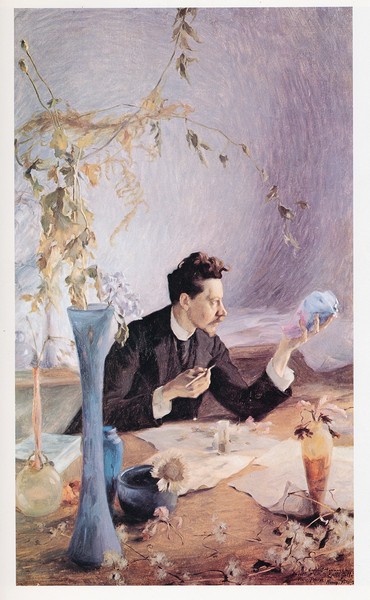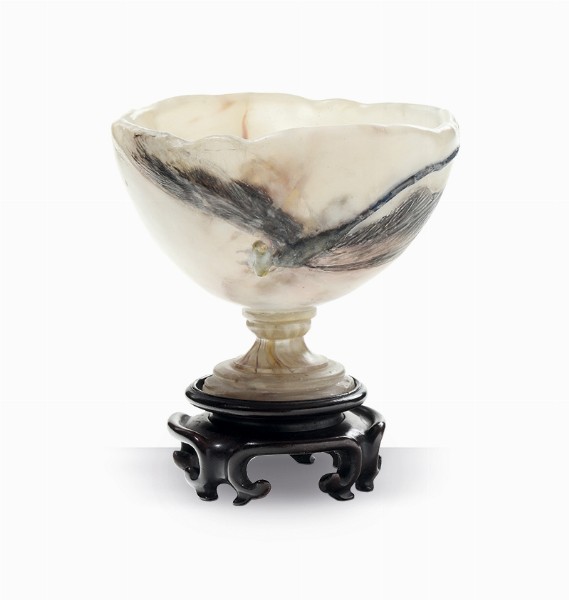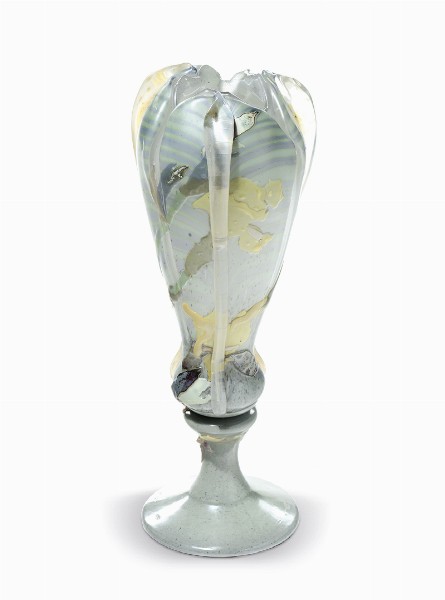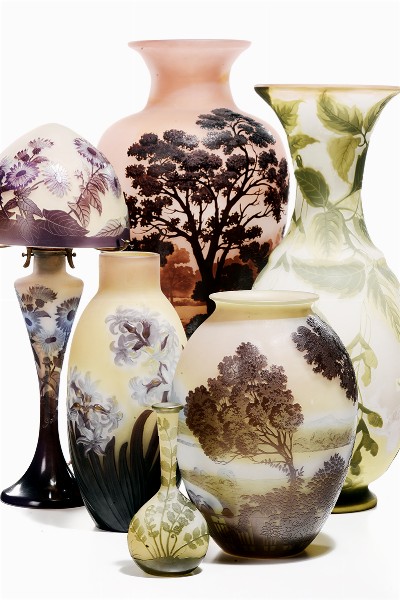Thea Casarino
Emile Gallé was born in Nancy in 1846, only child of Fanny Reinemer and Charles Gallé, crystals dealer and, afterwards, ceramic and glass decorator. After the lyceum, the young Emile spent a couple of years in various European cities, deepening his interest for art, philosophy and botany. In 1866, when he got back home, he was hired as apprentice at Burgun, Schverer & C., where he stayed until 1868. At the end of the Franco-Prussian War (1870–1871), where he fought as a volunteer, he started to work in his father workshop which had reached a huge success with enamel polychrome decoration on table glassware: Napoleon III himself had bought it for his residences. Emile took part in the Universal Exhibition in Paris in 1867, where he won an award; his art, however, was finally legitimised during the Universal Exhibition in Paris in 1889, where he got the Grand Prix and the Légion d’Honneur.Emile Gallé developed and patented many techniques, among which the multilayer glass, the cameo glass – obtained both with the incision with hydrochloric acid and the wheel – the marqueterie, the blow-moulding; in his huge production, particularly interesting is the verrerie parlante, in which sentences, usually taken from literary texts, are written on the piece and become an integral part of the decoration. During his never-ending research for artistic forms, he was highly impressed by Japanese art and produced many works recalling this oriental style.He was so appreciated by the people of his time that he was frequently mentioned by important intellectuals in their works, such as in the case of Marcel Proust in his Recherche. Proust himself, being a refined aesthete, commissioned him many pieces. Due to the long time needed to prepare his pieces, the high costs and in order to satisfy the requests of his clients, he had to enlarge his factory, and in 1880, he had around 300 employees. Emile Gallé was an eclectic artist: in addition to his glass production, he dedicated to painting, ceramic and, later on, cabinet-making. His work greatly influenced also Art Nouveau. His creations were essentially inspired by nature; the dragonfly was one of his favourite themes, always fascinated by this insect, symbol of life evolution. Among his first estimators there were the Museum of Fine Arts in Nancy and the one of the Decorative Arts in Luxembourg, which bought many pieces of his production. In 1901, at the peak of his career, he set up the École de Nancy. In the meanwhile the first symptoms of leukaemia appeared and in 1904, at 58, he died because of it. Many people mourned the artist who in his creations was able to express his spiritual and poetic vision of life.
Emile Gallé was born in Nancy in 1846, only child of Fanny Reinemer and Charles Gallé, crystals dealer and, afterwards, ceramic and glass decorator. After the lyceum, the young Emile spent a couple of years in various European cities, deepening his interest for art, philosophy and botany. In 1866, when he got back home, he was hired as apprentice at Burgun, Schverer & C., where he stayed until 1868. At the end of the Franco-Prussian War (1870–1871), where he fought as a volunteer, he started to work in his father workshop which had reached a huge success with enamel polychrome decoration on table glassware: Napoleon III himself had bought it for his residences. Emile took part in the Universal Exhibition in Paris in 1867, where he won an award; his art, however, was finally legitimised during the Universal Exhibition in Paris in 1889, where he got the Grand Prix and the Légion d’Honneur.Emile Gallé developed and patented many techniques, among which the multilayer glass, the cameo glass – obtained both with the incision with hydrochloric acid and the wheel – the marqueterie, the blow-moulding; in his huge production, particularly interesting is the verrerie parlante, in which sentences, usually taken from literary texts, are written on the piece and become an integral part of the decoration. During his never-ending research for artistic forms, he was highly impressed by Japanese art and produced many works recalling this oriental style.He was so appreciated by the people of his time that he was frequently mentioned by important intellectuals in their works, such as in the case of Marcel Proust in his Recherche. Proust himself, being a refined aesthete, commissioned him many pieces. Due to the long time needed to prepare his pieces, the high costs and in order to satisfy the requests of his clients, he had to enlarge his factory, and in 1880, he had around 300 employees. Emile Gallé was an eclectic artist: in addition to his glass production, he dedicated to painting, ceramic and, later on, cabinet-making. His work greatly influenced also Art Nouveau. His creations were essentially inspired by nature; the dragonfly was one of his favourite themes, always fascinated by this insect, symbol of life evolution. Among his first estimators there were the Museum of Fine Arts in Nancy and the one of the Decorative Arts in Luxembourg, which bought many pieces of his production. In 1901, at the peak of his career, he set up the École de Nancy. In the meanwhile the first symptoms of leukaemia appeared and in 1904, at 58, he died because of it. Many people mourned the artist who in his creations was able to express his spiritual and poetic vision of life.



